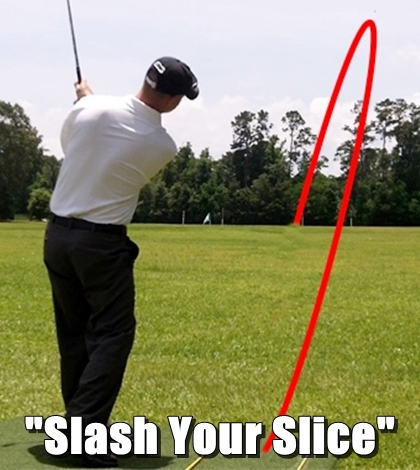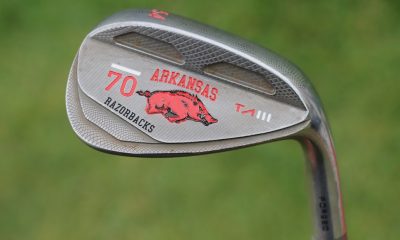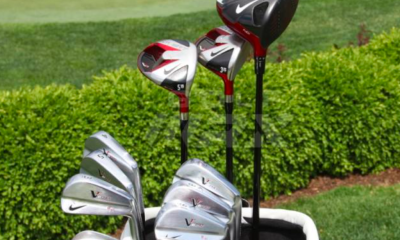Instruction
Slash Your Slice Part 3: Connecting The Pieces

After putting in some work on the last two Slash Your Slice articles (Slash Your Slice Part 1: Club Face Control, Slash Your Slice Part 2: Swing Path Control) and drills discussed in them you are now starting to enjoy a new shot pattern. Excellent job.
In Part 3, we will focus on the pivot and arm swing connection, which will continue to strengthen your draw.
For the sake of this article, let’s break the golf swing down into two main pieces. The pivot and the arm swing. The better our sense of connection between these two pieces, the easier it is to align and sequence our motion.
The Pivot: We will think of our pivot as the turning back and through of our body, including the knees, hips and shoulders. There is some weight shift and lateral motion involved, but nothing that we need to get bogged down in.
The Arm Swing: The arm swing is just that, the swinging back and forth of the arms from the shoulder sockets. This will also include the golf club once we assume our grip.
Connection Drill
Here I am hitting a less than full shot with a drink koozie underneath my lead arm. This simple exercise rewards us with a myriad of good things, but here are a few positives to take note of.
- The placing of an object underneath the arm activates the sensation of pressure between the upper arm and chest. We can then monitor this pressure and control the connection between our pivot and arm swing.
- In the backswing, many slicers make a very “vertical lifting” move with their lead arm. The lead arm can be seen covering their neck at the top of swing. The connection drill will “flatten” this overly steep and disconnected position, making for a much easier route to an on plane down swing, where the club shaft covers the trail forearm.
- The object does not fall out even in the through swing. This forces the pivot to keep working for the entire duration of the swing and helps stop over acceleration of the hands and arms. Thus a swing that is properly “sequenced”.
- Drill Bonus: When practicing this drill, we are not only improving our connection, but also learning the knock-down shot. A three-quarter length, aggressive chest/ arm swing can be your go to shot when you must hit the fairway or the green.
Post Impact Circle
In “Slash Your Slice” parts 1 and 2, we talked about the swiveling of the lead forearm. We also started using a circle, directed to the right to represent our golf swing.
The “Connection Drill” helps us control the swiveling of the lead forearm, which allows us to properly swing up the post impact side of our circle. The lack of swivel in the lead forearm results in the slicer’s “chicken wing.” Their lead elbow can be seen popping out from behind their chest early in the through swing.
Also, notice in both pictures how the shoulders are tilted and working around the spine. Slicers will tend to have a more vertical spine angle and higher right shoulder at this point.
A Constant
No matter what we are working on, it is always in direct context to these line relationships. It is simply a given that we always trace this down swing path for a draw.
Putting It All Together
A strong connection between the Pivot and Arm Swing will make all of our other changes even more efficient. For example, your clubface control will have a consistent rate of closure when your swivel is connected to a strong moving pivot.
Also, directing your swing path slightly inside-out will require less work when coming from a flatter lead arm position at the top. This all leads to our ultimate goal of two turns and the ball flies away with a little draw.
[youtube id=”kgJdnbBJgO8″ width=”620″ height=”360″]
- LIKE1
- LEGIT0
- WOW0
- LOL0
- IDHT0
- FLOP0
- OB0
- SHANK0
Instruction
Clement: Laid-off or perfect fade? Across-the-line or perfect draw?

Some call the image on the left laid off, but if you are hitting a fade, this could be a perfect backswing for it! Same for across the line for a draw! Stop racking your brain with perceived mistakes and simply match backswing to shot shape!
- LIKE1
- LEGIT0
- WOW0
- LOL0
- IDHT0
- FLOP0
- OB0
- SHANK1
Instruction
The Wedge Guy: The easiest-to-learn golf basic

My golf learning began with this simple fact – if you don’t have a fundamentally sound hold on the golf club, it is practically impossible for your body to execute a fundamentally sound golf swing. I’m still a big believer that the golf swing is much easier to execute if you begin with the proper hold on the club.
As you might imagine, I come into contact with hundreds of golfers of all skill levels. And it is very rare to see a good player with a bad hold on the golf club. There are some exceptions, for sure, but they are very few and very far between, and they typically have beat so many balls with their poor grip that they’ve found a way to work around it.
The reality of biophysics is that the body moves only in certain ways – and the particulars of the way you hold the golf club can totally prevent a sound swing motion that allows the club to release properly through the impact zone. The wonderful thing is that anyone can learn how to put a fundamentally sound hold on the golf club, and you can practice it anywhere your hands are not otherwise engaged, like watching TV or just sitting and relaxing.
Whether you prefer an overlap, interlock or full-finger (not baseball!) grip on the club, the same fundamentals apply. Here are the major grip faults I see most often, in the order of the frequency:
Mis-aligned hands
By this I mean that the palms of the two hands are not parallel to each other. Too many golfers have a weak left hand and strong right, or vice versa. The easiest way to learn how to hold the club with your palms aligned properly is to grip a plain wooden ruler or yardstick. It forces the hands to align properly and shows you how that feels. If you grip and re-grip a yardstick several times, then grip a club, you’ll see that the learning curve is almost immediate.
The position of the grip in the upper/left hand
I also observe many golfers who have the butt of the grip too far into the heel pad of the upper hand (the left hand for right-handed players). It’s amazing how much easier it is to release the club through the ball if even 1/4-1/2″ of the butt is beyond the left heel pad. Try this yourself to see what I mean. Swing the club freely with just your left hand and notice the difference in its release from when you hold it at the end of the grip, versus gripping down even a half inch.
To help you really understand how this works, go to the range and hit shots with your five-iron gripped down a full inch to make the club the same length as your seven-iron. You will probably see an amazing shot shape difference, and likely not see as much distance loss as you would expect.
Too much lower (right) hand on the club
It seems like almost all golfers of 8-10 handicap or higher have the club too far into the palm of the lower hand, because that feels “good” if you are trying to control the path of the clubhead to the ball. But the golf swing is not an effort to hit at the ball – it is a swing of the club. The proper hold on the club has the grip underneath the pad at the base of the fingers. This will likely feel “weak” to you — like you cannot control the club like that. EXACTLY. You should not be trying to control the club with your lower/master hand.
Gripping too tightly
Nearly all golfers hold the club too tightly, which tenses up the forearms and prevents a proper release of the club through impact. In order for the club to move back and through properly, you must feel that the club is controlled by the last three fingers of the upper hand, and the middle two fingers of the lower hand. If you engage your thumbs and forefingers in “holding” the club, the result will almost always be a grip that is too tight. Try this for yourself. Hold the club in your upper hand only, and squeeze firmly with just the last three fingers, with the forefinger and thumb off the club entirely. You have good control, but your forearms are not tense. Then begin to squeeze down with your thumb and forefinger and observe the tensing of the entire forearm. This is the way we are made, so the key to preventing tenseness in the arms is to hold the club very lightly with the “pinchers” — the thumbs and forefingers.
So, those are what I believe are the four fundamentals of a good grip. Anyone can learn them in their home or office very quickly. There is no easier way to improve your ball striking consistency and add distance than giving more attention to the way you hold the golf club.
More from the Wedge Guy
- The Wedge Guy: Golf mastery begins with your wedge game
- The Wedge Guy: Why golf is 20 times harder than brain surgery
- The Wedge Guy: Musings on the golf ball rollback
- LIKE88
- LEGIT15
- WOW6
- LOL1
- IDHT0
- FLOP4
- OB1
- SHANK9
Instruction
Clement: Stop ripping off your swing with this drill!

Not the dreaded headcover under the armpit drill! As if your body is defective and can’t function by itself! Have you seen how incredible the human machine is with all the incredible feats of agility all kinds of athletes are accomplishing? You think your body is so defective (the good Lord is laughing his head off at you) that it needs a headcover tucked under the armpit so you can swing like T-Rex?
- LIKE0
- LEGIT3
- WOW2
- LOL0
- IDHT0
- FLOP0
- OB0
- SHANK2
-

 19th Hole3 weeks ago
19th Hole3 weeks agoLET pro gives detailed financial breakdown of first week on tour…and the net result may shock you
-

 19th Hole1 week ago
19th Hole1 week agoReport: LIV star turns down PGA Championship invite due to ‘personal commitments’
-

 19th Hole2 weeks ago
19th Hole2 weeks agoGary Player claims this is what ‘completely ruined’ Tiger Woods’ career
-

 Equipment1 week ago
Equipment1 week agoDetails on Justin Thomas’ driver switch at the Wells Fargo Championship
-

 Whats in the Bag2 weeks ago
Whats in the Bag2 weeks agoTeam McIlowry (Rory McIlroy, Shane Lowry) winning WITBs: 2024 Zurich Classic
-

 Whats in the Bag1 week ago
Whats in the Bag1 week agoKeegan Bradley WITB 2024 (May)
-

 Equipment2 weeks ago
Equipment2 weeks agoGolf fans left surprised by LIV’s choice of course for its 2024 individual championship event
-

 Whats in the Bag3 days ago
Whats in the Bag3 days agoRory McIlroy’s winning WITB: 2024 Wells Fargo Championship























